- Home
- About Us
- Industry
- Services
- Reading
- Contact Us
MENA Metaverse Market: Current Analysis and Forecast (2023-2030)
Emphasis on Product Type (Infrastructure, Hardware, Software, and Services); Technology (Blockchain, Virtual Reality (VR) & Augmented Reality (AR), Mixed Reality (MR), and Others); and End-Use Industry (Aerospace & Defense, Education, Healthcare, Media & Entertainment, and Others); Country
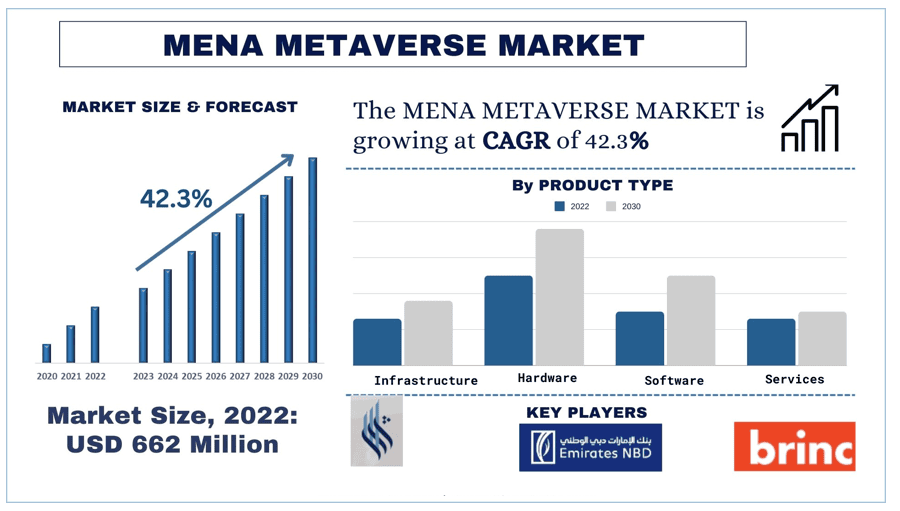
MENA Metaverse Market Size and Forecast
The MENA Metaverse Market is expected to grow at a strong CAGR of 42.3% during the forecast period.
MENA Metaverse Market Analysis
The metaverse refers to a hypothesized iteration of the internet that blends aspects of online virtual worlds, augmented reality, social media, and cryptocurrencies to allow users to interact virtually in a shared virtual space. In the metaverse, the digital and physical worlds are brought together in a unified, real-time simulation spanning multiple platforms and devices. For example, a metaverse platform could allow a user to purchase a virtual plot of land as an NFT asset using a cryptocurrency like Ethereum. The user can then develop the land, hosting virtual events or renting out advertising space. Crypto and NFTs enable new ownership models. Key characteristics of the metaverse include persistence, real-time interaction, interoperability, presence, platform convergence, blockchain integration, and hybrid reality blending digital and physical worlds. These features aim to evolve internet experiences into immersive shared virtual spaces. The emergence and adoption of blockchain technology, cryptocurrencies, and NFTs in the MENA region contributes to the demand for metaverse platforms and experiences. As virtual currencies and digital assets gain traction in MENA, more consumers are getting comfortable with the concepts underpinning crypto-enabled metaverse environments. The alignment of blockchain and metaverse innovation provides a boost to market growth potential.
Some of the major players operating in the market include e& etisalat and, Brinc Batelco, Chalhoub Group, Dubai Blockchain Center, Emirates NBD , Majid Al Futtaim, Meta, Metafora, Noon, and The Sandbox.
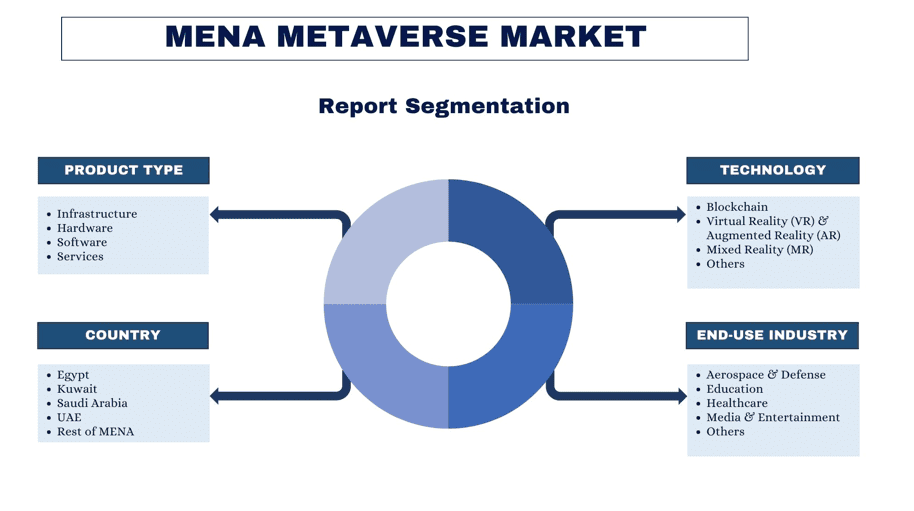
MENA Metaverse Market Trends
“Amongst product type, the infrastructure segment to hold a dominant share of the market in 2022”
The infrastructure segment includes the foundational technologies and platforms required to enable metaverse environments and experiences. This encompasses 5G networks, cloud computing capacity, blockchain and distributed ledgers, spatial computing frameworks, and the integration layers to allow interoperability between virtual worlds. Robust infrastructure is crucial for the functioning of real-time, high-fidelity metaverse spaces. Companies like telecom providers and technology vendors are major drivers of infrastructure spending for the metaverse in MENA. Their initiatives and investments have been focused on back-end infrastructure.
“Amongst technology, the Virtual Reality (VR) & Augmented Reality (AR) category to hold a dominant share of the market in 2022”
Virtual Reality (VR) & Augmented Reality (AR) led the MENA metaverse market in 2022. VR/AR technologies are more consumer-ready and commercially available compared to blockchain or mixed reality which are still emerging. Major tech companies like Meta, Microsoft, HTC, and others are heavily investing in VR/AR hardware and software development tailored for metaverse experiences.
“UAE to grow with high CAGR during the forecast period.”
The UAE’s Metaverse market is driven by both public and private sector initiatives. Major UAE-based corporations like Aldar Properties, Majid Al Futtaim, and Etisalat have announced metaverse projects. The Dubai Metaverse Assembly hosted by the Dubai Future Foundation brings together businesses, experts, and youth to discuss metaverse trends. Educational institutions like the University of Dubai are launching metaverse-focused programs. With this level of coordinated government and corporate backing for Web 3.0 and metaverse technologies, the UAE aims to solidify its position as a global leader in adopting and leveraging virtual world platforms to drive economic growth and progress. The broader MENA region can gain insights from the UAE’s approach to metaverse strategy and planning.
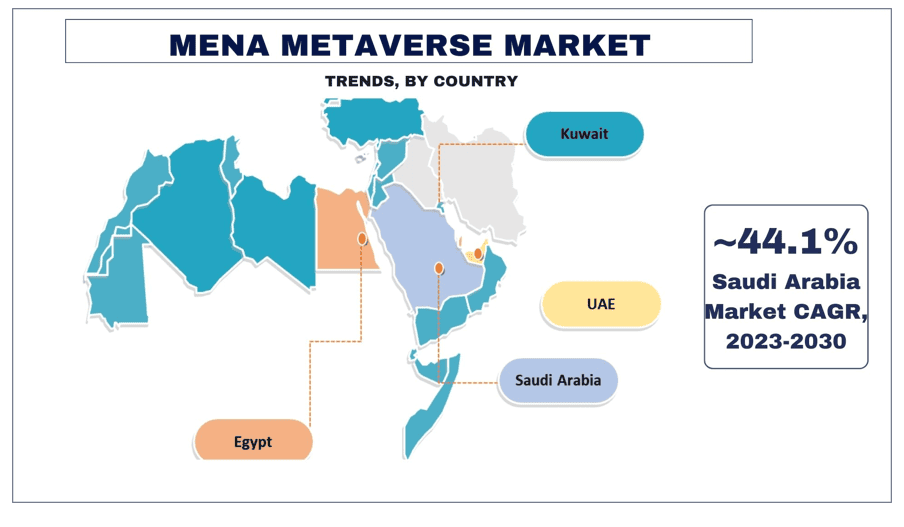
MENA Metaverse Market Report Coverage
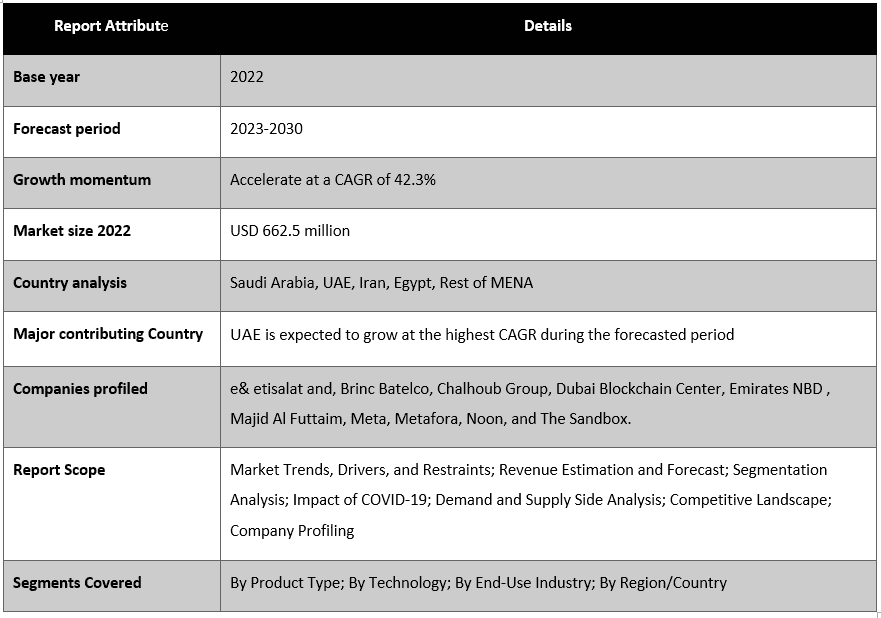
Reasons to buy this report:
- The study includes market sizing and forecasting analysis validated by authenticated key industry experts.
- The report presents a quick review of overall industry performance at one glance.
- The report covers an in-depth analysis of prominent industry peers with a primary focus on key business financials, product portfolios, expansion strategies, and recent developments.
- Detailed examination of drivers, restraints, key trends, and opportunities prevailing in the industry.
- The study comprehensively covers the market across different segments.
- Deep dive regional level analysis of the industry.
Customization Options:
The MENA Metaverse market can further be customized as per the requirement or any other market segment. Besides this, UMI understands that you may have your own business needs, hence feel free to connect with us to get a report that completely suits your requirements.
Table of Content
Research Methodology for the MENA Metaverse Market Analysis (2023-2030)
Analyzing the historical market, estimating the current market, and forecasting the future market of the MENA Metaverse market were the three major steps undertaken to create and analyze the adoption of MENA Metaverse in major countries. Exhaustive secondary research was conducted to collect the historical market numbers and estimate the current market size. Secondly, to validate these insights, numerous findings and assumptions were taken into consideration. Moreover, exhaustive primary interviews were also conducted, with industry experts across the value chain of the MENA Metaverse market. Post assumption and validation of market numbers through primary interviews, we employed a top-down/bottom-up approach to forecasting the complete market size. Thereafter, market breakdown and data triangulation methods were adopted to estimate and analyze the market size of segments and sub-segments of the industry pertains to. Detailed methodology is explained below:
Analysis of Historical Market Size
Step 1: In-Depth Study of Secondary Sources:
Detail secondary study was conducted to obtain the historical market size of the MENA Metaverse market through company internal sources such as annual reports & financial statements, performance presentations, press releases, etc., and external sources including journals, news & articles, government publications, competitor publications, sector reports, third-party database, and other credible publications.
Step 2: Market Segmentation:
After obtaining the historical market size of the MENA Metaverse market, we conducted a detailed secondary analysis to gather historical market insights and share for different segments & sub-segments for major regions. Major segments are included in the report as product type, technology, and end-use industry. Further country-level analyses were conducted to evaluate the overall adoption of testing models in that region.
Step 3: Factor Analysis:
After acquiring the historical market size of different segments and sub-segments, we conducted a detailed factor analysis to estimate the current market size of the MENA Metaverse market. Further, we conducted factor analysis using dependent and independent variables such as product type, technology, and end-use industry of the MENA Metaverse market. A thorough analysis was conducted for demand and supply-side scenarios considering top partnerships, mergers and acquisitions, business expansion, and product launches in the MENA Metaverse market sector across the globe.
Current Market Size Estimate & Forecast
Current Market Sizing: Based on actionable insights from the above 3 steps, we arrived at the current market size, key players in the MENA Metaverse market, and market shares of the segments. All the required percentage shares split, and market breakdowns were determined using the above-mentioned secondary approach and were verified through primary interviews.
Estimation & Forecasting: For market estimation and forecast, weights were assigned to different factors including drivers & trends, restraints, and opportunities available for the stakeholders. After analyzing these factors, relevant forecasting techniques i.e., the top-down/bottom-up approach were applied to arrive at the market forecast for 2030 for different segments and sub-segments across the major markets. The research methodology adopted to estimate the market size encompasses:
- The industry’s market size, in terms of revenue (USD) and the adoption rate of the MENA Metaverse market across the major markets domestically
- All percentage shares, splits, and breakdowns of market segments and sub-segments
- Key players in the MENA Metaverse market in terms of products offered. Also, the growth strategies adopted by these players to compete in the fast-growing market
Market Size and Share Validation
Primary Research: In-depth interviews were conducted with the Key Opinion Leaders (KOLs) including Top Level Executives (CXO/VPs, Sales Head, Marketing Head, Operational Head, Regional Head, Country Head, etc.) across major regions. Primary research findings were then summarized, and statistical analysis was performed to prove the stated hypothesis. Inputs from primary research were consolidated with secondary findings, hence turning information into actionable insights.
Key Stakeholders of Metaverse Market in the MENA Region
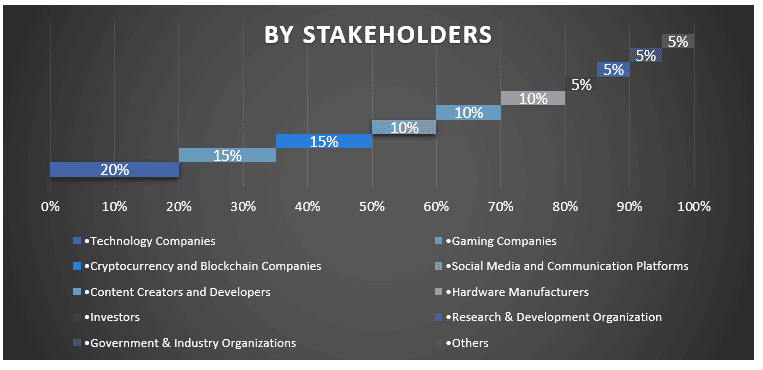
Market Engineering
The data triangulation technique was employed to complete the overall market estimation and to arrive at precise statistical numbers for each segment and sub-segment of the MENA Metaverse market. The data was split into several segments & sub-segments post studying various parameters and trends in the areas of the product type, technology, and end-use industry of the MENA Metaverse market.
The main objective of the MENA Metaverse Market Study
The current & future market trends of the MENA Metaverse market were pinpointed in the study. Investors can gain strategic insights to base their discretion for investments on the qualitative and quantitative analysis performed in the study. Current and future market trends determined the overall attractiveness of the market at a regional and country level, providing a platform for the industrial participant to exploit the untapped market to benefit from a first-mover advantage. Other quantitative goals of the studies include:
- Analyze the current and forecast market size of the MENA Metaverse market in terms of value (USD). Also, analyze the current and forecast market size of different segments and sub-segments
- Segments in the study include areas of the product type, technology, and end-use industry
- Define and analysis of the regulatory framework for the MENA Metaverse industry
- Analyze the value chain involved with the presence of various intermediaries, along with analyzing customer and competitor behaviors of the industry
- Analyze the current and forecast market size of the MENA Metaverse market for the major region
- Major countries of regions studied in the report include Saudi Arabia, UAE, Egypt, Iran, and the Rest of MENA
- Company profiles of the MENA Metaverse market and the growth strategies adopted by the market players to sustain in the fast-growing market
- Deep dive regional level analysis of the industry
Related Reports
Customers who bought this item also bought










